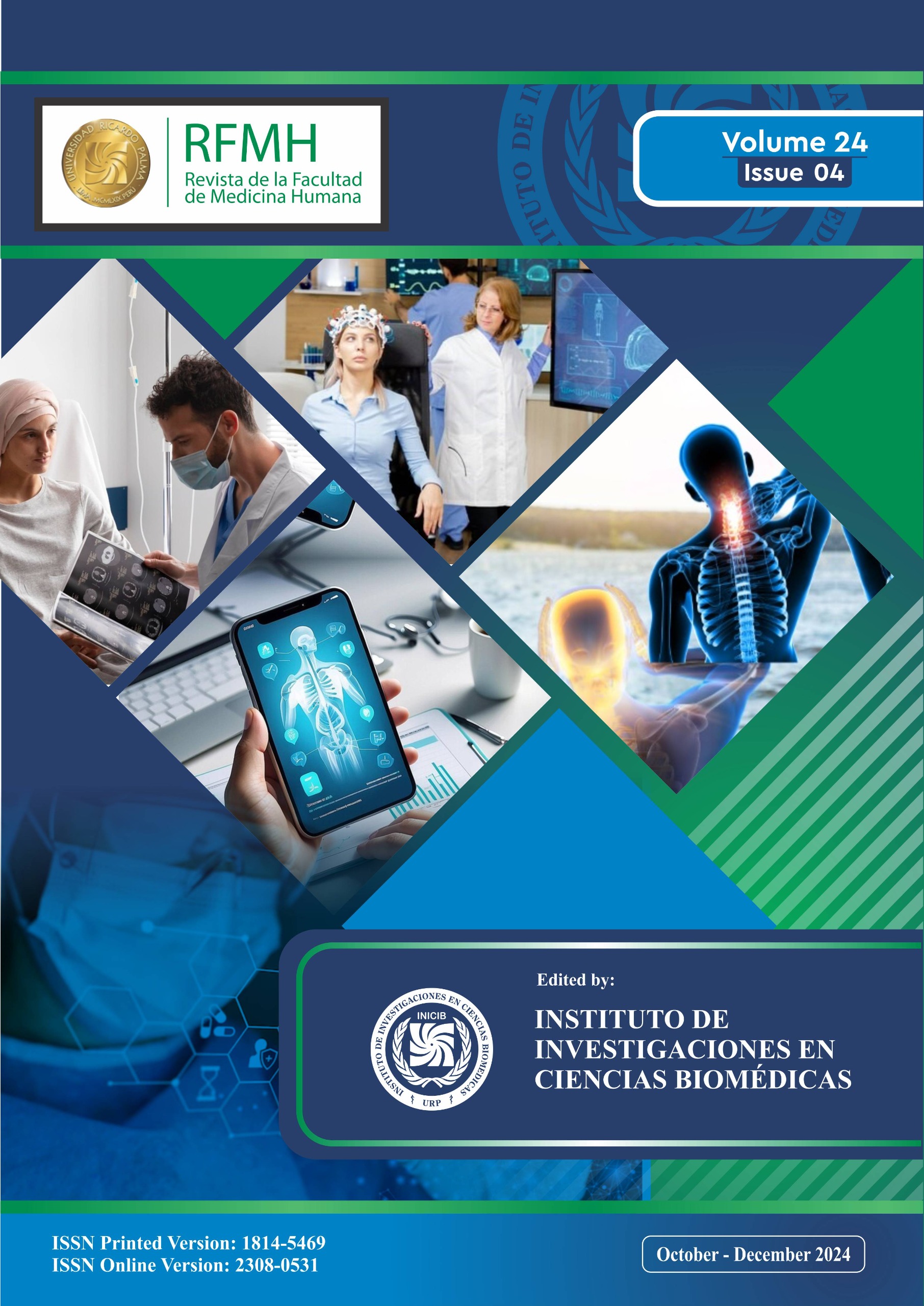Descripción de los factores genéticos asociados a la conducta suicida y suicidio: una revisión de tema
Description of genetic factors associated with suicidal behavior and suicide: a topical review | 与自杀行为和自杀相关的遗传因素描述:专题综述
Palabras clave:
Conducta, suicidio, depresión, marcadores genéticos, variación genética, serotonina, dopamina, norepinefrinaResumen
Introducción: El suicidio y las conductas suicidas (CS) son un fenómeno complejo y multideterminado en el que interactúan diferentes factores genéticos, ambientales e individuales. El objetivo de este estudio fue realizar una revisión de los factores genéticos asociados a la conducta suicida descritos en la literatura de los últimos 10 años. Métodos: Se realizó una búsqueda de todos los artículos disponibles tanto artículos de revisión, como reportes de caso y guías de manejo bajo los descriptores en ciencias de la salud (DeCS) Conducta suicida, suicidio, depresión, exoma, marcadores genéticos, variación genética, genoma humano, serotonina, norepinefrina, dopamina, biología computacional en las bases de Google scholar, LILACS, PubMed y ClinicalKe, se consultaron sitios web oficiales como los de Organización Mundial de la Salud (OMS) y Ministerio de Salud y Protección Social de Colombia. Desarrollo: Los estudios genéticos de las CS, llevan décadas intentando encontrar el “gen del suicidio”, con el fin de identificar de manera prematura aquellas personas con mayor riesgo de realizar intentos suicidas y prevenir que se conviertan en víctimas; sin embargo, estos estudios fallaron en encontrar un gen o grupo de éstos que diferenciara entre sujetos suicidas y no suicidas. A este tipo de tecnología surgieron los estudios de asociación del genoma completo (GWAS), con los cuales algunos autores quisieron demostrar las diferencias del genoma de pacientes con ideas suicidas. Conclusiones: El conocimiento de los factores genéticos implicados puede llevar a que sea posible identificar los individuos con mayor riesgo de desarrollar comportamiento suicida, de esta forma tener mejores herramientas y recibir una visión más mecanicista para explorar la red intermolecular subyacente y prevenir las muertes por esta causa.
Descargas
Citas
Durkheim É. Le suicide. [Internet] 2013 [cited 25 Aug 2021]. Disponible en: https://www.puf.com/content/Le_suicide
World Health Organization [Internet]. Mhgap intervention guidelines for mental disorders, neurological and substance use in the level, 2010. [cited 23 Aug 2021] Disponible en: www.who.int/mental_health/mhgap.
Fondo de las Naciones Unidas para la Infancia (UNICEF) [Internet]. El suicidio en la adolescencia. Situación en la Argentina, 2019. [cited 23 Aug 2021]. Disponible en: https://www.unicef.org/argentina/media/6326/file/Suicidio_adolescencia.pdf
Serrano Ruiz CP, Olave Chaves JA. Factores de riesgo asociados con la aparición de conductas suicidas en adolescentes. MedUNAB. 2017 [consultado 20 Jul 2021]; 20(2):139–47
World Health Organization. Preventing suicide: a global imperative (WHO, 2021) Suicidio, datos y cifras. https://www.who.int/es/news-room/fact-sheets/detail/suicide
Cortés-Alfaro A, Román-Hernández M, Suárez-Medina R, Alonso-Uría R. Conducta suicida, adolescencia y riesgo. Anales de la Academia de Ciencias de Cuba [Internet]. 2021 [citado 5 Sep 2022]; 11 (2) Disponible en: http://www.revistaccuba.cu/index.php/revacc/article/view/939
Dirección Territorial de Salud de Caldas [Internet]. Informe anual comportamiento de los intentos de suicidio en el departamento de Caldas año de 2017. 2017 [cited 4 Mar 2021]. Disponible en: http://observatorio.saluddecaldas.gov.co/desca/saludm/Intentos%20de%20Suicidio%20Informe%20anual%202017.pdf
Ministerio de Salud y Protección Social. Subdirección de Enfermedades no Transmisibles [Internet]. Boletín de salud mental conducta suicida. 2018. [consultado 20 Abr. 2021]. Disponible en: https://www.minsalud.gov.co/sites/rid/Lists/BibliotecaDigital/RIDE/VS/PP/ENT/boletin-conducta-suicida.pdf
González T, Tovilla C, Genis A, Juárez I, et al. Identification of gene ontology and pathways implicated in suicide behavior: Systematic review and enrichment analysis of GWAS studies. American Journal of Medical Genetics Part B: Neuropsychiatric Genetics [Internet]. 2019 [citado 14 Mar 2021]; 180(Issue 5): 320-329. Disponible en: http://dx.doi.org/10.1002/ajmg.b.32731
Nock M, Borges G, Bromet E, Christine B, Cha R, Kessler R, et al. Suicide and Suicidal Behavior. Epidemiologic Reviews [Internet]. 2008 [citado 29 Abr 2021]; 30(1):133-154. Disponible en: http://dx.doi.org/10.1093/epirev/mxn002
Gmitrowicz A. Suicidal Behaviours among Polish Youth in Light of the following Papers: Suicidal Behaviour in Children and Adolescents. Parts 1 and 2. The Canadian Journal of Psychiatry [Internet]. 2010 [citado 29 Abr 2021]; 55(6):389-400. Disponible en: http://dx.doi.org/10.1177/070674371005500615
Cortés A, Aguilar J, Suárez R, Rodríguez E, y Durán JS. Factores de riesgo asociados con el intento suicida y criterios sobre lo ocurrido en adolescentes. Rev Cubana Med Gen Integr [Internet]. 2011. [citado 25 Marzo 2021]; 27(1):33-41. Disponible en: http://scielo.sld.cu/scielo.php?script=sci_arttext&pid=S0864-21252011000100004&lng=es.
Nock MK, Borges G, Bromet EJ, Cha CB, Kessler RC, & Lee S. Suicide and suicidal behavior. Epidemiologic Reviews [Internet] 2008. [cited 21 Mar 2021]; 30(1):133–154. Available from: http://dx.doi.org/10.1093/epirev/mxn002
Sarmiento Hernández EI, Ulloa Flores RE, Brenes Prats ME, Camarena Medellín B, Aguilar García A, & Hernández Muñoz S. El polimorfismo 5-HTTLPR y el intento suicida en adolescentes deprimidos. Salud Mental [Internet]. 2014 [cited 24 Abr. 2021]; 37(2):97-101. Disponible en: http://www.scielo.org.mx/scielo.php?script=sci_arttext&pid=S0185-33252014000200002&lng=es
Brent D, Emslie G, Clarke G, Wagner KD, Asarnow JR, Keller M, et al. Switching to another SSRI or to venlafaxine with or without cognitive behavioral therapy for adolescents with SSRI-resistant depression: the TORDIA randomized controlled trial: The TORDIA randomized controlled trial. JAMA [Internet]. 2008 [cited 24 Abr. 2021]; 299(8):901–13. http://dx.doi.org/10.1001/jama.299.8.901
Mirkovic B, Laurent C, Podlipski M-A, Frebourg T, Cohen D, Gerardin P. Genetic association studies of suicidal behavior: A review of the past 10 years, progress, limitations, and future directions. Front Psychiatry [Internet]. 2016 [cited 24 Abr. 2021]; 7:158. Available from: http://dx.doi.org/10.3389/fpsyt.2016.00158
Galfalvy H, Haghighi F, Hodgkinson C, Goldman D, Oquendo MA, Burke A, et al. A genome-wide association study of suicidal behavior. Am J Med Genet B Neuropsychiatr Genet [Internet]. 2015 [cited 14 May 2021]; 168(7):557–63. Available from: http://dx.doi.org/10.1002/ajmg.b.32330
Roy B, Dwivedi Y. Understanding epigenetic architecture of suicide neurobiology: A critical perspective. Neurosci Biobehav Rev [Internet]. 2017 [cited 21 May 2021]; 72:10–27. Available from: http://dx.doi.org/10.1016/j.neubiorev.2016.10.031
Muñoz I. Neurobiología del suicidio. Dialnet [Internet]. 2021 [cited 28 Abr 2021]; 10(2018): 17-47. Available from: https://dialnet.unirioja.es/servlet/articulo?codigo=6573026
Clayden RC, Zaruk A, Meyre D, Thabane L, Samaan Z. The association of attempted suicide with genetic variants in the SLC6A4 and TPH genes depends on the definition of suicidal behavior: a systematic review and meta-analysis. Transl Psychiatry [Internet]. 2012 [cited 28 Abr 2021]; 2(10):e166. Available from: http://dx.doi.org/10.1038/tp.2012.96
Musci RJ, Augustinavicius JL, Volk H. Gene-environment interactions in psychiatry: Recent evidence and clinical implications. Curr Psychiatry Rep [Internet]. 2019 [cited 29 Abr 2021]; 21(9):81. Available from: http://dx.doi.org/10.1007/s11920-019-1065-5
Pivac N, Pregelj P, Nikolac M, Zupanc T, Nedic G, Muck Seler D, et al. The association between catechol-O-methyl-transferase Val108/158Met polymorphism and suicide. Genes Brain Behav [Internet]. 2011 [cited 12 May 2021]; 10(5):565–9. Available from: http://dx.doi.org/10.1111/j.1601-183X.2011.00695.x
Calati R, Porcelli S, Giegling I, Hartmann AM, Möller H-J, De Ronchi D, et al. Catechol-o-methyltransferase gene modulation on suicidal behavior and personality traits: review, meta-analysis and association study. J Psychiatr Res [Internet]. 2011 [cited 12 Jun 2021]; 45(3):309–2 Available from: http://dx.doi.org/10.1016/j.jpsychires.2010.07.004
González-Castro TB, Hernández-Díaz Y, Juárez-Rojop IE, López-Narváez ML, Tovilla-Zárate CA, Ramírez-Bello J, et al. The role of COMT gene Val108/158Met polymorphism in suicidal behavior: systematic review and updated meta-analysis. Neuropsychiatr Dis Treat [Internet]. 2018 [cited 25 Feb 2021]; 14:2485–96. Available from: http://dx.doi.org/10.2147/NDT.S172243
Lung F-W, Tzeng D-S, Huang M-F, Lee M-B. Association of the MAOA promoter uVNTR polymorphism with suicide attempts in patients with major depressive disorder. BMC Med Genet [Internet]. 2011 [cited 17 Jun 2021]; 12:74. Available from: http://dx.doi.org/10.1186/1471-2350-12-74
Buttenschøn HN, Flint TJ, Foldager L, Qin P, Christoffersen S, Hansen NF, et al. An association study of suicide and candidate genes in the serotonergic system. Journal of Affective Disorders [Internet]. 2013 [cited 29 Abr 2021]; 148(2–3):291–298. Available from: http://dx.doi.org/10.1016/j.jad.2012.12.011
Hung CF, Lung FW, Hung TH, Chong MY, Wu CK, Wen JK, et al. Monoamine oxidase gene polymorphism and suicide: An association study and meta-analysis. Journal of Affective Disorders [Internet]. 2012 [cited 13 Abr 2021]; 136(3):643–649. Available from: http://dx.doi.org/10.1016/j.jad.2011.10.013
Zai CC, Manchia M, De Luca V, Tiwari AK, Chowdhury NI, Zai GC, et al. The brain-derived neurotrophic factor gene in suicidal behaviour: a meta-analysis. The International Journal of Neuropsychopharmacology [Internet]. 2012 [cited 11 May 2021]; 15(8):1037–42. Available from: http://dx.doi.org/10.1017/S1461145711001313

Descargas
Publicado
Cómo citar
Número
Sección
Licencia
Derechos de autor 2024 Revista de la Facultad de Medicina Humana

Esta obra está bajo una licencia internacional Creative Commons Atribución 4.0.





























